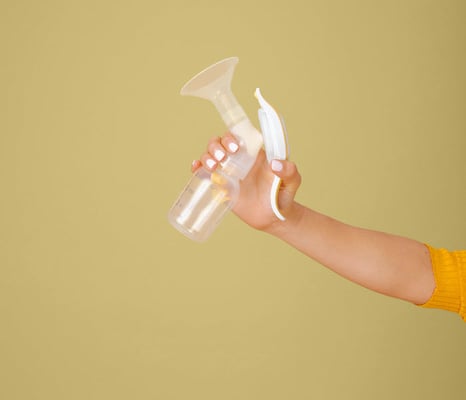5 Pumping Hacks to Get Pumped About Pumping, and Keep the Milk Up
By Milk Stork Team on August 5, 2020

Pumping sucks, literally… But it can still be rewarding with a few hacks to help keep the milk flowing.
Milk is released from the breasts with the help of the love hormone, oxytocin. Oxytocin is created when you snuggle with your baby, see their gummy smile, smell their scent, hear that ridiculously adorable giggle, etc. It’s what causes the milk letdown and gets things going. Some women feel it, some do not – and that’s ok.
It is not created when you place cold plastic triangles on your breasts and start a noisy suction device that pinches your nipples in awkward positions until it fits. The throbbing sound of the pump motor doesn’t help create that love hormone, either. Surround that by a day of endless meetings, possibly a missed meal or two, running late to pump, and you’ve got a recipe for an oxytocin wasteland.
This is the real reason behind the fear and inevitable reality of milk decreasing when mothers return to work or are exclusive pumpers for long periods.
Plus, the fact that a plastic triangle looks nothing like a baby’s mouth doesn’t help with the physical needs to stimulate the release of that hormone. So, we have to fake it a little! Here are some tips to get pumping going and to stay pumped about it.
TIP #1: The Human Touch
Use your hands and fingers to shake your breasts, gently pull your nipples, hand express for a few minutes. The human touch will trigger that release from your brain. This gets your girls prepped and ready for action.
TIP #2: Sense of Smell
Once you’re plugged in and turned on, smell your baby’s jammies or extra blanket (yes, you too can have a baby blankie as an adult!). Smell directly triggers the brain, and who doesn’t instantly love the scent of their baby? It’s a recipe for an immediate oxytocin dump and milk letdown!

Videos of your baby’s sounds – the coos, laughs, giggles, and even the cries – trigger that audible oxytocin.
TIP #3: Don’t Stress!
“You get what you get, you don’t get upset“ – many women stare at the bottles and worry about what’s coming out and what’s not. And with each pull of the pump that it’s not, the stress hormones start to be released. Stress hormones are worst enemy to oxytocin and decrease its levels very quickly – therein lies the reason for unsuccessful pumping and perceived reduced milk supply.
TIP #4: Covering Up Distractions
You’ve got milk! You are just having a hard time getting it out, so relax and let oxytocin do its thing. Cover up your bottles with baby socks, blankets, your scarf – whatever will prevent you from looking at it and stressing. Put your focus on that video you took of baby’s first belly laugh last week.
TIP #5: Massage and Compress
Compress the girls – babies use suction *and* compression of the nipple and breast to remove milk from a breast successfully. A pump only provides nipple suction, so half of the usual feeding mechanism is missing, usually producing half the milk!
Gently massaging and compressing all areas of your breast while pumping will help provide that other half. Use a soft fist to roll on the outer parts of your breast toward your nipple, the palm of your hand to massage down from your upper chest, fingers to massage your inner breasts, etc.

Remember to not be so hard on yourself when it comes to pumping! Although it may feel impossible at times, don’t forget to relax and take your time throughout the process.


